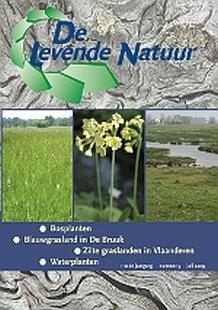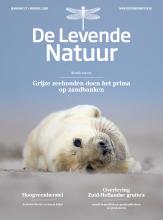De Levende Natuur nummer 5 van 2009 (English summary)
Afbeelding

Restoration of fen meadows in the Bruuk
M. Jongman, F.H. Everts, A.P.Grootjans & H. Woesthuis
De Bruuk is a fen meadow reserve of almost 90 hectares situated near Nijmegen. In 1989 only 6 ha consisted of well developed fen meadow vegetation (0.7 ha Cirsio dissecti-Molinietum and 5.3 ha Crepido-Juncetum acutiflori). This represents 10 % of what has been left of these plant communities in The Netherlands. As most fen meadow reserves in The Netherlands, De Bruuk is surrounded by intensively used agricultural fields, which have been deeply drained between 1970 and 1980. As a result, the fen meadows became desiccated due to which the calcareous and iron-rich groundwater could not reach the top soil any longer. Many characteristic species of fen meadows have disappeared due to lower water tables and subsequent acidification. Since 1995 hydrological measures have been taken to stop this drainage. After purchasing agricultural land in the vicinity of the reserve some large ditches have been filled in with loamy material to stop drainage. In the reserve large parts of the acidified top soil have been removed by sod cutting.
This study evaluates the results of these restoration measures, based on vegetation mapping in 1989 (before the restoration measures) and in 1998 and in 2007 (after these measures). Since 1995 the area of well developed fen meadow types has increased from 6 ha to 9.7 ha, an increase of more than 60%. On a national level the increase is about 8 % which stresses the importance of this nature reserve. The study also concludes that additional measures still will be necessary in order to further improve the discharge of base-rich groundwater into the top soil of the reserve.
Will forest plant communities ever establish in post-agricultural forest?
L. Baeten, M. Vanhellemont, H. Van Calster, M. Hermy, A. De Schrijver & K. Verheyen
After the afforestation of agricultural land, forest herbs need to colonize the recent forest site from source populations. Whereas dispersal is the first bottleneck that limits colonization, (a)biotic legacies from former agricultural land use can subsequently hamper the establishment of forest herbs. In two introduction experiments, we found that the different life stages (germination, recruitment, survival) of forest herbs were directly and indirectly hampered by nutrient enrichment from former fertilization (mainly phosphorus). We concluded that the strong fertilization legacies in recent forests represent – just like in other vegetation types – a persistent limitation for the development of a diverse herbaceous vegetation.
Restoration of brackish plant communities in Flemish coastal polders
J.P. Bakker, K. Remans, R.M. Bekker, H. Steendam, J. van Gompel & M. Hermy
Flemish coastal polders developed from embankments of former salt marshes during the 8th-10th century. They originated from peatland formed behind the coastal dunes. During later transgression periods these peatlands were covered by clay from tidal inundations. Since medieval times clay and peat were mined resulting in low-lying wet grasslands with brackish soil conditions. After the 1960s, re-allotment programs with subsequent agricultural intensification left only a small fraction of the original extensive brackish grasslands harbouring the nowadays rare Agrostio-Trifolietum fragiferi communities. The soil seed bank of these communities includes many brackish species. But a degenerated field, after 20 years of intensification also revealed viable seeds of species such as Samolus valerandi, Juncus ambiguus, J. gerardii and J. inflexus. The sod of this degenerated field was cut, and the emerged plants included the species mentioned from the seed bank, but also Spergularia salina, Ranunculus sardous, Glaux maritima, Aster tripolium and Puccinellia distans. We conclude that a vast amount of species of the brackish communities have a good chance to be restored from the soil seed bank.
Constructed shallow zones along navigation canals
G. Boedeltje, B. Besteman, P.P. Duijn & M. de la Haye
From 1983 onwards, shallow zones (or backwaters) have been constructed along navigation canals in The Netherlands which form a potential new habitat for rooted submerged and emergent aquatic plants absent from traditional canals. The banks of these canals consist of an unprotected slope, which gradually changes from land into a 0.6 to 1.2 m deep water zone. A defence (dam or sheet piles) separates this zone from the much deeper canal. Most of the shallow zones are connected to the canal by means of gaps or pipes in the wave-breaking structure. Hydrochorous plant dispersal was studied in the Twentekanaal, a canal in the eastern part of The Netherlands. Over a period of 10-22 years, colonization and vegetation succession have been studied in the Twentekanaal as well as in two canals in the southern part of The Netherlands: the Wilhelminakanaal and Zuid-Willemsvaart. These canals have high nutrient loads, a pH of 7.8, and a total alkalinity between 2 and 4 meq L-1.
In the Twentekanaal, an enormous number of viable diaspores was trapped, representing species of aquatic, semi-aquatic and terrestrial habitats. The abundant occurrence of their diaspores indicates that the potential establishment of aquatic species in backwaters is not likely constrained by dispersal limitation. Rooted submerged aquatic plant communities indeed established in several backwaters, but their occurrence appeared to be transient. A vegetation of Common reed established in the transition zone between water and land. It greatly extended into the deeper parts of the backwaters resulting in dense stands within 8-10 years. Sheltered backwaters with standing canal water appeared to be dominated by duckweed layers.
Effects of floodplain restoration on wintering waterbirds
L. van den Bremer, C.A.M. van Turnhout, M. van Roomen & B. Voslamber
Since the late 1980s a large number of agricultural floodplains along the large rivers Rhine and Meuse have been transformed into new nature areas, where natural processes such as flooding, morphodynamics, semi-natural grazing and spontaneous vegetation development were reactivated. The effects of the first ten years of this large-scale floodplain rehabilitation on 19 species of common wintering waterbirds are analysed, using the developments in their population sizes in 213 counting sites in 1987-2005, of which 31 sites concern ecological rehabilitation projects. For 14 species positive effects of floodplain rehabilitation on linear trends were found, for the remaining five species we found negative effects. Waterfowl species feeding on fish, benthos and water plants generally seem to have benefited from rehabilitation measures, probably caused by the increase in the area of (shallow) water bodies (such as side-channels) and an increase in the frequency of inundation of floodplains after excavation. Effects of floodplain rehabilitation for four species of grassland herbivores are negative, probably caused by a decrease in their foraging habitat, resulting from the replacement of fertilized agricultural grasslands by less nutritious natural grasslands and shrubs. Possibilities to optimise rehabilitation measures in relation to nature legislation are discussed.
The Dutch conservationist, Hans Gorter: a worried optimist
Along with Eli Heimans and Jac. P. Thijsse, the well-known pioneers in Dutch nature conservation, Hans Gorter (1914-2001) may be considered one of the most prominent Dutch conservationists. His personal archives, giving a good impression of his activities in this field, are inserted in the archives of the ‘Heimans & Thijsse Stichting’, in Amsterdam.
Originally, Hans Gorter was a jurist with a passion for nature conservation. In 1940 he took up his appointment at the ‘Vereniging Natuurmonumenten’, the main Dutch non-governmental nature conservation organization, where he rose to director. Under his management ‘Natuurmonumenten’ grew into a more democratic and public-minded organization. At an early date Gorter was also involved in activities of the ‘Contact-Commissie voor Natuur- en Landschapsbescherming’ (an overarching organization in the field of nature and landscape conservation) and he got management functions in numerous other nature and environmental organizations.
After his retirement, in 1979, he wrote a standard work on the history of the ‘Vereniging Natuurmonumenten’. Gorter was not quite easy about the future of nature in The Netherlands; he defined himself as a ‘worried’ optimist.

